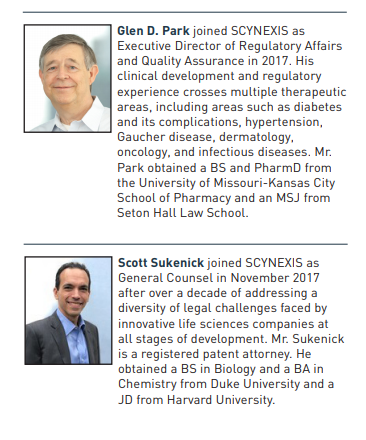
The Challenges of Communicating Regulatory Status to the Public
By Glen Park and Scott Sukenick
One of the biggest challenges for a public company in the pharmaceutical and biotechnology industry is interpreting statements the Food and Drug Administration (FDA) makes to the company with respect to potential negative regulatory action. The way the company interprets and presents such statements to the public is particularly critical for small clinical-stage companies whose very survival can be threatened by a whiff of bad news. Deciding what information about communications with FDA must be disclosed to the public and crafting statements to stockholders that fairly describe those communications can be some of the most difficult decisions for clinical-stage companies.
Clearly, there is no need for a company to disclose all regulatory back-and-forth communications with FDA, particularly concerning potential risks so remote or uncertain that they do not merit disclosure. Just as clearly, however, communications that are material to the company must be disclosed. Securities and Exchange Commission (SEC) Rule 10b-5, implementing the Securities Exchange Act of 1934 (Exchange Act), makes it unlawful “to make any untrue statement of material fact or to omit to state a material fact necessary in order to make the statements made, in light of the circumstances under which they were made, not misleading” when done with scienter (intent or knowledge of wrongdoing) in connection with the purchase or sale of securities. Negative consequences of failure to adequately communicate material information regarding regulatory status can originate from the SEC in civil actions, the Department of Justice in criminal actions, or from stockholders who have a private right of action to sue if the company communication is not truthful or is misleading—all of which can be painful for companies of any size, but can be particularly severe for small, clinical-stage companies.
William O. Fisher has provided a comprehensive legal review of the difficulty in predicting the outcome of regulatory actions, including the accuracy of predictions of FDA approval and timing.[1] This review aims to build upon Fisher’s work by analyzing a recent case where the SEC brought civil action against a company and its executives based on the adequacy of the company’s disclosures regarding communications from FDA. This example can help guide company thinking about interpreting the materiality of those communications for purposes of complying with the Exchange Act and emphasizes the importance of adequate regulatory and legal advice in addressing such questions.
Facts of the Case
AVEO Pharmaceuticals, Inc. (AVEO), a publicly traded company, develops drug products to treat cancer.[2] To support a New Drug Application (NDA) for its lead compound, AVEO conducted a Phase 3 clinical trial evaluating the drug’s safety and efficacy compared to an approved product. Based on the results of this single trial, AVEO met with FDA for a pre-NDA meeting. The data indicated that the trial met its primary endpoint (progression-free survival), but that a secondary endpoint (overall survival) trended in a negative direction. At the pre-NDA meeting, FDA staff voiced doubts about the drug’s risk-to-benefit ratio because of the secondary endpoint results, with one member of the FDA staff suggesting that the trend in the secondary endpoint could cause FDA to issue a Refuse to File (RTF) letter. The minutes of the pre-NDA meeting stated, in relevant part:
The Agency expressed concern about the adverse trend in overall survival. Further discussion of these findings will be required at the time of filing and if the application is filed they will be a review issue that could affect approvability. FDA recommended that the sponsor conduct a second adequately powered randomized trial . . . .”
AVEO executives recognized that there was a “high risk” of an RTF letter or non-approval if they submitted the NDA without data from an additional trial, and AVEO did design a second trial, but the design was not acceptable to FDA. Rather than pursuing an acceptable design, AVEO decided it would submit the NDA with only the one completed trial. AVEO did not make any public statements about the pre-NDA meeting until issuing a press release three months later in connection with its quarterly SEC filing. That press release noted that FDA expressed concerns about the trend in overall survival, but stated that AVEO believed subsequent data analyses would directly address the issue. The press release did not mention the FDA recommendation to conduct a second trial. Likewise, AVEO executives did not disclose this information in subsequent investor and analyst calls, instead claiming that they could not speculate as to whether FDA might want AVEO to conduct an additional trial.
AVEO subsequently submitted its NDA, which FDA accepted for substantive review. FDA sent a Day 74 letter in which it stated that the trial results remained a “significant safety concern” and scheduled an Advisory Committee review. Between the Day 74 letter and the Advisory Committee meeting, AVEO raised $53.8 million in connection with a stock offering based on a prospectus and related documents, which continued to omit any mention of the FDA’s recommendation for a second trial or that there was a high risk of non-approval without data from a second trial.
In anticipation of the Advisory Committee meeting, FDA and AVEO each released public briefing documents. FDA’s briefing document disclosed that, at the pre-NDA meeting, FDA had recommended that AVEO conduct a second trial. That day, AVEO’s stock lost 30% of its value. The Advisory Committee then voted thirteen to one against approval of the NDA, and FDA subsequently issued a Complete Response Letter denying approval based on the single study submitted.
The SEC filed a civil complaint against AVEO and its Chief Executive Officer (CEO), Chief Medical Officer (CMO), and Chief Financial Officer (CFO) for violations of SEC regulations. The SEC subsequently entered into a consent judgment with AVEO and settled with the CEO and CMO. The CFO, however, fought the charges as the case progressed to summary judgment and, ultimately, a jury trial.
Duty to Disclose/Materiality
The CFO argued that FDA’s advice to conduct a second clinical trial was not material information, since it was merely a recommendation and not a directive. He contended that FDA’s recommendation was part of a normal regulatory back-and-forth between AVEO and FDA, and it was not certain that a second trial would be needed for AVEO to obtain NDA approval. The CFO argued that the drug approval process is an inherently risky endeavor and that normal risks and uncertainties that arise in ongoing regulatory discussions did not constitute material information requiring public disclosure.
The SEC countered that FDA’s recommendation was clearly material to AVEO and its investors. The evidence cited by the SEC included: (1) the NDA was for AVEO’s only drug candidate, on which the company’s success depended; (2) a company slide deck recognized that failure to conduct a second trial would lead to a high risk of non-approval; (3) the company planned and budgeted for a second trial; and (4) subsequent disclosure of FDA’s recommendation led to a significant decrease in AVEO’s stock price, with many investors selling the stock.
Scienter
The CFO argued that scienter, or the requisite state of mind to deceive, could not be established because of the uncertainty of regulatory outcome and his belief that there was not a duty to disclose an uncertain outcome. He also argued that his understanding of the risk was attenuated, since he did not participate in the pre-NDA meeting at which FDA made the recommendation, and his understanding of the regulatory risk came from the advice from two regulatory experts—an attorney and a former FDA official. The CFO also argued that risk factors in AVEO’s SEC filings about adverse overall survival data from the clinical trial serve to weaken an inference of scienter.
The SEC disagreed, contending that the CFO knew that AVEO faced a high risk of non-approval without a second trial; knew that communications with investors and analysts were intentionally incomplete; and could not rely on arguments based on attorney advice, since AVEO had not waived its privilege with respect to that advice. The SEC also argued that the language in the risk factors was insufficient to negate scienter, since FDA’s recommendation to conduct a second trial—and the high risk of non-approval without it—was not addressed in the risk factors.
Analysis
Materiality
It is well-accepted that all interesting information may not be material information. Rather, information is considered material if it would alter the total mix of facts in a way that there is a substantial likelihood that a reasonable shareholder would consider it important to the investment decision. Where that information involves a possibility that a future event adverse to the company will occur, the materiality of the information depends on a balance between the probability that an event will occur and the potential magnitude of the event, considering the totality of the company activity.
In this case, AVEO recognized that there was a high risk it would fail to obtain approval for its NDA unless it followed FDA’s recommendation to conduct a second clinical trial. Since the NDA concerned AVEO’s lead compound, on which the success of the company was dependent, failure to obtain approval likely would have significant financial implications. Therefore, a reasonable investor might consider FDA’s recommendation to be material information.
AVEO initially prepared to follow FDA’s recommendation to conduct a second clinical trial by budgeting for and designing the trial and submitting it to FDA for consideration. Designing additional clinical trials in the face of regulatory uncertainty might be considered a prudent risk-management step if additional data proved necessary. In this case, however, the additional clinical trial was designed in response to a clear recommendation from FDA that it might be necessary for approval, and AVEO’s actions in planning this second trial support the materiality of FDA’s recommendation.
After FDA rejected the design of the second trial, AVEO made the decision to submit the NDA with only the initial trial. It is not unusual for companies to take the risk of submitting NDAs with data uncertainty after FDA has indicated that the uncertainty would be a “review issue”; after all, with full review of the data, the initial impression of FDA could be changed by a more clear presentation of the data and/or the benefit-to-risk analysis. Those review issues, however, are not usually related to a major study safety outcome such as an imbalance in mortality. Furthermore, in this case AVEO already knew that FDA was skeptical of its data analysis arguments.
Some facts of this case did weigh in AVEO’s favor. For example, despite FDA’s pre-NDA statements, including the possibility that NDA submission might result in an RTF letter, FDA did accept AVEO’s NDA for substantive review, indicating that on its face the deficiency in the data did not prevent a substantive review.[3] Furthermore, FDA prospectively scheduled an Advisory Committee meeting to obtain the Committee’s feedback, suggesting that the data deficiency was not so egregious that FDA felt comfortable rejecting the study results outright. Those facts, combined with the advice of two regulatory consultants, one of whom was a former FDA official, could have been seen as suggesting a lower risk of non-approval than originally anticipated. Unfortunately for AVEO, the market did not see it this way, as shown by the stock price drop upon disclosure of FDA’s recommendation. Furthermore, by the time the NDA was accepted for filing and an Advisory Committee meeting was scheduled, AVEO and its executives had already elected to hide the facts of FDA’s recommendation and the attendant high risk of a non-approval, while claiming that they had no knowledge of what additional data FDA might want to see.
Role of Risk Factors
Along the same lines, this case is an example of how mere disclosure of risk factors is not necessarily enough. AVEO did provide strong hints of the limitations of its data by identifying risks in its SEC filings such as “risks relating to whether the results of [the single study] are sufficient to obtain marketing approval” and how FDA would view the safety and efficacy of the drug, “including its data with respect to [progression free survival], the rate of adverse events, [overall survival,] and other information that the FDA may determine relevant to approvability,” and finally that FDA “could require additional positive clinical trials as the basis for product approval.” The risks identified by these cautionary statements, however, could not be fully appreciated by the public because material information was withheld, such as details of the pre-NDA meeting discussion, and misleading statements were made, such as “FDA has not required” a second clinical trial.
Comparison to Cases
While the AVEO case may not have been a particularly close call, a determination of fraud in this case was certainly not as clear-cut as in others. For example, in the Vaso Active case,[4] the company held an IPO and made claims in press releases and SEC filings that three products had either been “approved by FDA” or “are qualified under FDA OTC monographs and have been registered as such.” In fact, none of the products had ever been submitted to FDA for marketing approval in an NDA, nor would any have met OTC monograph criteria. While investors may be faulted somewhat for not understanding the OTC product regulatory procedures well enough to at least suspect some foul play, this was a clear case of fraudulent statements.
A more analogous case may be that of Transkaryotic Therapies, Inc. (TKT), a bio-pharmaceutical company based in Cambridge, Massachusetts.[5] TKT made false statements that clinical trials for TKT’s flagship drug, Replagal, were a success and made positive statements about Replagal’s chances of being approved for sale in the U.S. by FDA. In fact, FDA had informed TKT that its principal clinical trial was a failure and that Replagal would not receive FDA approval based on that trial.
After submission of an application for approval, TKT made scientific presentations describing the successful results of the pivotal study with reference to a secondary pain analysis but never mentioned that the primary efficacy analysis (the analysis on which FDA based its condition of approval) had failed to show a statistically significant benefit. One particularly misleading slide purported to show the results of the primary efficacy analysis having a p value of 0.02, much better than the desired level of 0.05 or less for demonstrating statistical significance. In reality, the p value of 0.02 was associated with the secondary pain analysis; the p value of the primary efficacy analysis was a much worse, and not statistically significant, 0.19.
FDA issued a complete response letter (CRL) that was critical of several issues related to the pivotal trial and recommended that TKT conduct another trial. TKT issued a press release the next day that stated only that FDA had asked for additional data and that TKT employees were working to provide the requested information. The press release did not disclose that, far from just asking for more information, FDA had informed TKT that the pivotal study failed to achieve its primary objective and had recommended that TKT conduct additional clinical trials. For more than two years after the CRL, TKT continued to issue misleading communications until it received a negative vote at an Advisory Committee meeting.
TKT clearly intended to mislead investors by presenting information that suggested that the trial was successful without presenting FDA’s statements regarding the probability of approval based on review of the data. TKT management presumably believed there was some hope of obtaining approval based on its decision to continue to pursue the program with FDA from more than two years after the CRL.[6] It may be that it hoped there was enough evidence that Replagal worked in the orphan Fabry disease that FDA would exercise its regulatory flexibility in applying the substantial evidence approval requirement as it had before and continues to do under conditions of serious diseases with unmet medical need.
Conclusion
Communicating the content of discussions with regulatory agencies about the probability of a product’s approval to investors can be a tricky balance between what is an actual outcome versus a hypothetical outcome—and where to draw the line regarding the materiality of potential actions in the future.
As noted by Fisher[7], “[s]ome courts have in the past relied on a three-part test to determine whether a prediction is false:
A projection or statement of belief contains at least three implicit factual assertions: (1) that the statement is genuinely believed, (2) that there is a reasonable basis for that belief, and (3) that the speaker is not aware of any undisclosed facts tending to seriously undermine the accuracy of the statement. A projection or statement of belief may be actionable [i.e., “false” under the securities laws] to the extent that one of these implied factual assertions is inaccurate.”
Both AVEO and TKT may have believed, naively, that they could convince FDA of the approvability of the products they submitted in marketing applications. Whether AVEO or TKT truly believed that their prediction of FDA approval was likely or possible without conduct of another clinical trial, they both failed to have a reasonable basis for that belief and were both aware of undisclosed facts that undermined the accuracy of the statement. A vague statement of risk of FDA requiring additional information is not an adequate defense when the company already has information that FDA was highly likely to require additional information for approval based on statements already made.
Part of the AVEO CFO’s defense was that “his conception of the risk” of FDA not approving the product was not based on his own knowledge and experience but “instead from the advice of two regulatory experts, an attorney and a former FDA official.” Whether those two regulatory experts had the requisite experience and knowledge to accurately interpret the likelihood of FDA approval is not clear. Regardless, this defense does emphasize the importance of being able to accurately communicate the meaning of FDA statements in the context of the probability of a future regulatory action and to not ignore when FDA is trying to tell you something. While FDA may change its mind after a complete and in-depth review of data, once it issues an opinion indicating a likelihood to not approve based on available data, regulatory experts should recognize that the recommendation is not likely to change.
[1] William O. Fisher, Key Disclosure Issues for Life Sciences Companies: FDA Product Approval, Clinical Test Results, and Government Inspections, 8 Mich. Telecomm. & Tech. L. Rev. 115 (2002).
[2] Sec. & Exch. Comm’n v. Johnston, Civil Action No. 16-10607-NMG (D. Mass. Apr. 19, 2018).
[3] 21 CFR § 314.101(d)(3) provides that FDA may refuse to file an NDA if “(t)he NDA . . . is incomplete because it does not on its face contain information required under section 505(b) . . . of the Federal Food, Drug, and Cosmetic Act and § 314.50 . . . .”
[4] Securities and Exchange Commission v. Vaso Active Pharmaceuticals, Inc., Civil Action No. 04 CV 01395 (RJL) (D.D.C.).
[5] Securities and Exchange Commission v. Richard B. Selden, Civil Action No. 0511805 (NMG) (D.D.C.).
[6] Of course, it is also possible that management simply wanted to drag out the process for as long as they could.
[7] Fisher, supra note 1, at 118.
Update Magazine
November/December 2019





